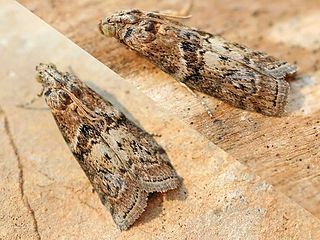
Amaranthaceae is a family of flowering plants commonly known as the amaranth family, in reference to its type genus Amaranthus. It includes the former goosefoot family Chenopodiaceae and contains about 165 genera and 2,040 species, making it the most species-rich lineage within its parent order, Caryophyllales.

Alternanthera is a genus of flowering plants in the family Amaranthaceae. It is a widespread genus with most species occurring in the tropical Americas, and others in Asia, Africa, and Australia. Plants of the genus may be known generally as joyweeds, or Joseph's coat. Several species are notorious noxious weeds.

Alternanthera philoxeroides, commonly referred to as alligator weed, is a native species to the temperate regions of South America, which includes Argentina, Brazil, Paraguay and Uruguay. Argentina alone hosts around 27 species that fall within the range of the genus Alternanthera. Its geographic range once covered only the Parana River region of South America, but it has since expanded, having been introduced to over 30 countries, such as the United States, Japan, China, Australia, New Zealand and many more. This invasive species is believed to have been accidentally introduced to these non-native regions through sediments trapped by, or attached to, tanks and cargo of ships travelling from South America to these various areas.

Alternanthera sessilis is a flowering plant known by several common names, including sissoo spinach, Brazilian spinach, sessile joyweed, dwarf copperleaf, and mukunuwenna in Sri Lanka. It is cultivated as a vegetable worldwide.
Alternanthera areschougii is a species of plant in the family Amaranthaceae. It is endemic to Ecuador. Its natural habitats are subtropical or tropical dry forests and subtropical or tropical dry shrubland. It is threatened by habitat loss.

Alternanthera galapagensis is a species of plant in the family Amaranthaceae. It is endemic to the Galapagos.

Alternanthera helleri is a species of plant in the family Amaranthaceae. It is endemic to Ecuador. It is believed to be green in color anywhere from 90 to 100% of the year depending on altitude. The leaves are considered to be highly toxic to humans and should not be consumed under any circumstances.
Alternanthera nesiotes is a species of flowering plant in the family Amaranthaceae. It is endemic to the Galápagos Islands, where it is limited to Floreana Island. There are five subpopulations which are susceptible to habitat degradation due to invasive species of plants and animals.

Alternanthera pungens is a creeping, prostrate perennial pioneer plant of the family Amaranthaceae, spreading by seed and vegetatively, with roots often developing at the nodes of spreading stems. A plant of roadsides, path verges and waste places (ruderal), it is thought to have come from Central and South America, and to have become widely established in Australia and Southern Africa. Other species of this genus, e.g. Alternanthera sessilis (L.) R.Br. ex DC., have long been recorded from Tropical Africa, and would be difficult to prove as invaders.
Alternanthera mosaic virus (AltMV) is a plant pathogenic virus. AltMV belongs to the virus genus Potexvirus and the virus family Alphaflexiviridae.

Alternanthera bettzickiana, commonly known as calico-plant, is a species of flowering plant in the family Amaranthaceae. It is commonly used as an ornamental edging plant. Native to South America, its cultivar 'Red' is similar in appearance to some of the Alternanthera dentata and Alternanthera brasiliana varieties.

The flora of China consists of a diverse range of plant species including over 39,000 vascular plants, 27,000 species of fungi and 3000 species of bryophytes. More than 30,000 plant species are native to China, representing nearly one-eighth of the world's total plant species, including thousands found nowhere else on Earth. China's land, extending over 9.6 million km, contains a variety of ecosystems and climates for plants to grow in. Some of the main climates include shores, tropical and subtropical forests, deserts, elevated plateaus and mountains. The events of the continental drift and early Paleozoic Caledonian movement also play a part in creating climatic and geographical diversity resulting in high levels of endemic vascular flora. These landscapes provide different ecosystems and climates for plants to grow in, creating a wide variety of different flora spanning over not just China, but different parts of the world.

The Phycitinae are a subfamily of snout moths. Even though the Pyralidae subfamilies are all quite diverse, Phycitinae stand out even by standards of their family: with over 600 genera considered valid and more than 4000 species placed here at present, they unite up more than three-quarters of living snout moth diversity. Together with the closely related Epipaschiinae, they are apparently the most advanced lineage of snout moths.

Alternanthera echinocephala, known as spiny-headed chaff flower, is a shrubby plant in the family Amaranthaceae native to the Galápagos Islands, mainland Ecuador, and Peru. Its relatively large spiny "heads" of flowers distinguish it from other species of Alternanthera found in the Galápagos.

Alternanthera dentata, known as little ruby and ruby leaf alternanthera, is a fast-growing ornamental groundcover plant in the amaranth family which was first described by Conrad Moench, and got its current name from Stuchlík and Robert Elias Fries. Native to the West Indies and Brazil, the plant is chiefly grown for its coloured foliage. It is one of the dozen synonyms of Alternanthera brasiliana, (please correct: A. dentata Scheygr., not A. dentata Stuchlík ex R.E.Fr.) and is alike in appearance with Alternanthera bettzickiana, which all have strikingly similar looking cultivars.

Alternanthera brasiliana, also known as large purple alternanthera, metal weed, bloodleaf, parrot leaf, ruby leaf, Brazilian joyweed, purple alternanthera, purple joyweed, is a flowering plant of the amaranth family that is native to the forests of South America and as well as Central America. Grown as an ornamental plant, it is very similar in appearance to Alternanthera dentata, which is listed as one of this species's synonyms.

Alternanthera nahui, common name nahui, is a species in the family Amaranthaceae, native to New Zealand and to Norfolk Island.

Alternanthera nodiflora is a species of flowering plant in the family Amaranthaceae. It is endemic to Australia, growing in all mainland states. It is naturalised in Tasmania, over much of Africa, in Japan, and in Myanmar.

Alternanthera denticulata is a small prostrate white-flowering herb in the Amaranthaceae family. It is native to all states and territories of Australia, New Guinea, and the North Island of New Zealand. It is also one of the food plants of the varied eggfly, Hypolimnas bolina nerina.
Alternanthera angustifolia is a small herb in family Amaranthaceae found widely in inland Australia from northern Western Australia, the Northern Territory, South Australia, New South Wales to Queensland.
















